Report on Employment Law: Employee Status and Recent Case Laws
VerifiedAdded on 2020/10/23
|11
|3319
|58
Report
AI Summary
This report delves into the complexities of UK employment law, focusing on the different statuses of employment: employees, workers, and independent contractors. It examines the rights and protections afforded to each category under the Employment Rights Act 1996 and highlights the importance of accurately determining employment status. The report explores the impact of the gig economy and the challenges it poses to traditional employment models, including the rise of zero-hour contracts and agency workers. It analyzes key common law tests used to identify employment contracts, such as control, mutuality of obligation, and personal service. Furthermore, the report provides an in-depth analysis of recent case laws, including Pimlico Plumbers v Smith, Addison Lee v Gascoigne, and Uber v Aslam, illustrating how courts are interpreting employment law in the context of modern working practices. The report concludes by discussing the implications of these legal developments for both employers and employees, emphasizing the need for clear and accurate contractual terms to define employment status and ensure fair treatment in the workplace.

Employment Law
Paraphrase This Document
Need a fresh take? Get an instant paraphrase of this document with our AI Paraphraser
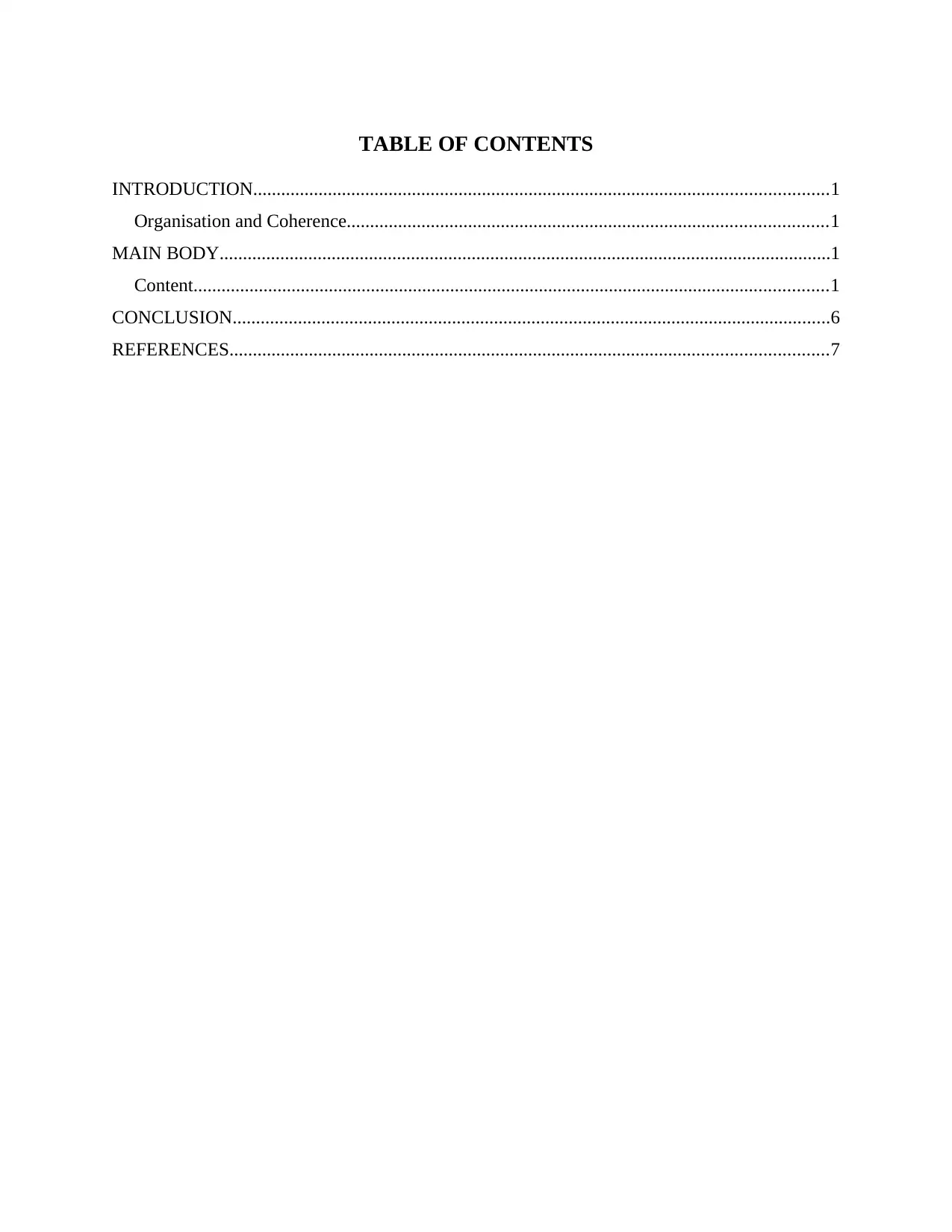
TABLE OF CONTENTS
INTRODUCTION...........................................................................................................................1
Organisation and Coherence.......................................................................................................1
MAIN BODY...................................................................................................................................1
Content........................................................................................................................................1
CONCLUSION................................................................................................................................6
REFERENCES................................................................................................................................7
INTRODUCTION...........................................................................................................................1
Organisation and Coherence.......................................................................................................1
MAIN BODY...................................................................................................................................1
Content........................................................................................................................................1
CONCLUSION................................................................................................................................6
REFERENCES................................................................................................................................7
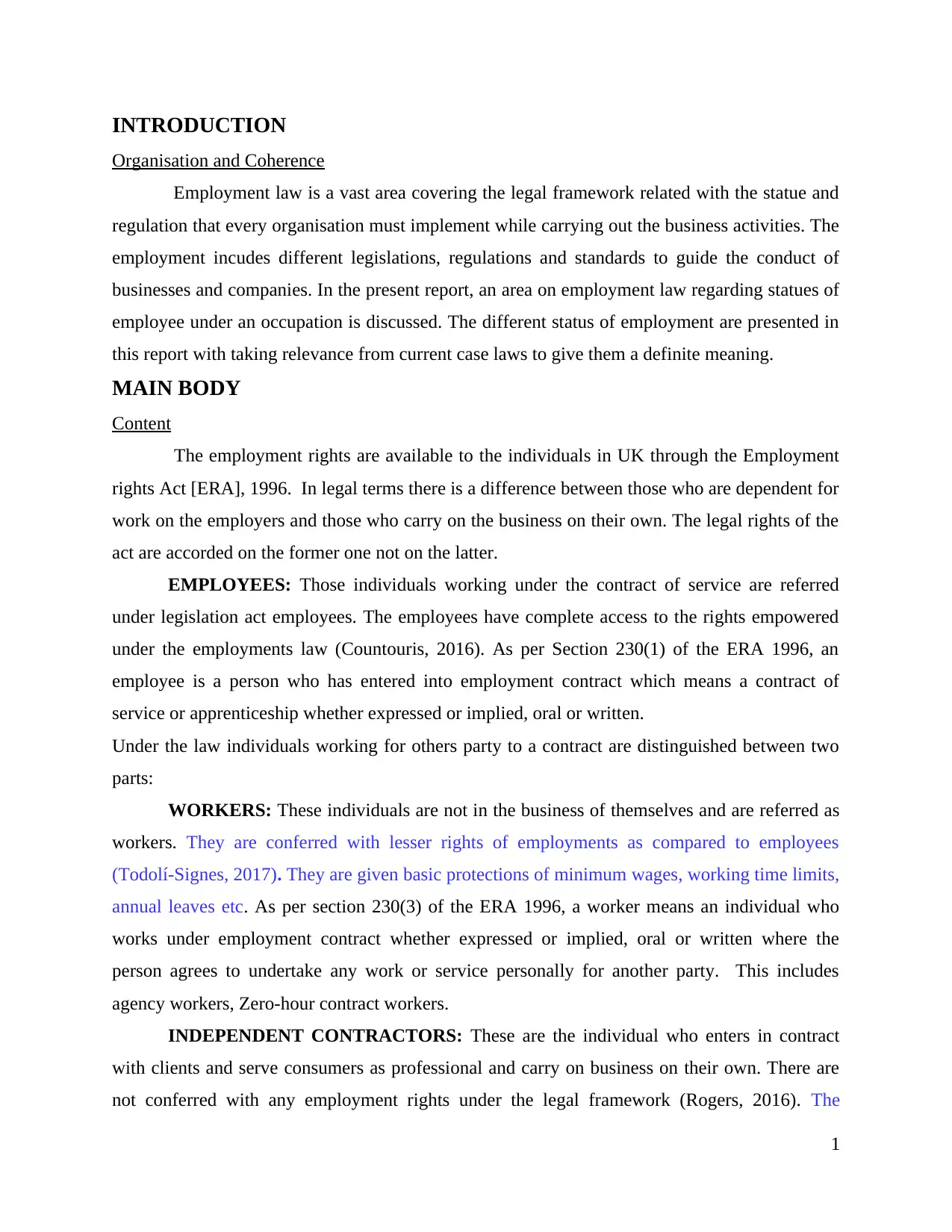
INTRODUCTION
Organisation and Coherence
Employment law is a vast area covering the legal framework related with the statue and
regulation that every organisation must implement while carrying out the business activities. The
employment incudes different legislations, regulations and standards to guide the conduct of
businesses and companies. In the present report, an area on employment law regarding statues of
employee under an occupation is discussed. The different status of employment are presented in
this report with taking relevance from current case laws to give them a definite meaning.
MAIN BODY
Content
The employment rights are available to the individuals in UK through the Employment
rights Act [ERA], 1996. In legal terms there is a difference between those who are dependent for
work on the employers and those who carry on the business on their own. The legal rights of the
act are accorded on the former one not on the latter.
EMPLOYEES: Those individuals working under the contract of service are referred
under legislation act employees. The employees have complete access to the rights empowered
under the employments law (Countouris, 2016). As per Section 230(1) of the ERA 1996, an
employee is a person who has entered into employment contract which means a contract of
service or apprenticeship whether expressed or implied, oral or written.
Under the law individuals working for others party to a contract are distinguished between two
parts:
WORKERS: These individuals are not in the business of themselves and are referred as
workers. They are conferred with lesser rights of employments as compared to employees
(Todolí-Signes, 2017). They are given basic protections of minimum wages, working time limits,
annual leaves etc. As per section 230(3) of the ERA 1996, a worker means an individual who
works under employment contract whether expressed or implied, oral or written where the
person agrees to undertake any work or service personally for another party. This includes
agency workers, Zero-hour contract workers.
INDEPENDENT CONTRACTORS: These are the individual who enters in contract
with clients and serve consumers as professional and carry on business on their own. There are
not conferred with any employment rights under the legal framework (Rogers, 2016). The
1
Organisation and Coherence
Employment law is a vast area covering the legal framework related with the statue and
regulation that every organisation must implement while carrying out the business activities. The
employment incudes different legislations, regulations and standards to guide the conduct of
businesses and companies. In the present report, an area on employment law regarding statues of
employee under an occupation is discussed. The different status of employment are presented in
this report with taking relevance from current case laws to give them a definite meaning.
MAIN BODY
Content
The employment rights are available to the individuals in UK through the Employment
rights Act [ERA], 1996. In legal terms there is a difference between those who are dependent for
work on the employers and those who carry on the business on their own. The legal rights of the
act are accorded on the former one not on the latter.
EMPLOYEES: Those individuals working under the contract of service are referred
under legislation act employees. The employees have complete access to the rights empowered
under the employments law (Countouris, 2016). As per Section 230(1) of the ERA 1996, an
employee is a person who has entered into employment contract which means a contract of
service or apprenticeship whether expressed or implied, oral or written.
Under the law individuals working for others party to a contract are distinguished between two
parts:
WORKERS: These individuals are not in the business of themselves and are referred as
workers. They are conferred with lesser rights of employments as compared to employees
(Todolí-Signes, 2017). They are given basic protections of minimum wages, working time limits,
annual leaves etc. As per section 230(3) of the ERA 1996, a worker means an individual who
works under employment contract whether expressed or implied, oral or written where the
person agrees to undertake any work or service personally for another party. This includes
agency workers, Zero-hour contract workers.
INDEPENDENT CONTRACTORS: These are the individual who enters in contract
with clients and serve consumers as professional and carry on business on their own. There are
not conferred with any employment rights under the legal framework (Rogers, 2016). The
1
⊘ This is a preview!⊘
Do you want full access?
Subscribe today to unlock all pages.

Trusted by 1+ million students worldwide
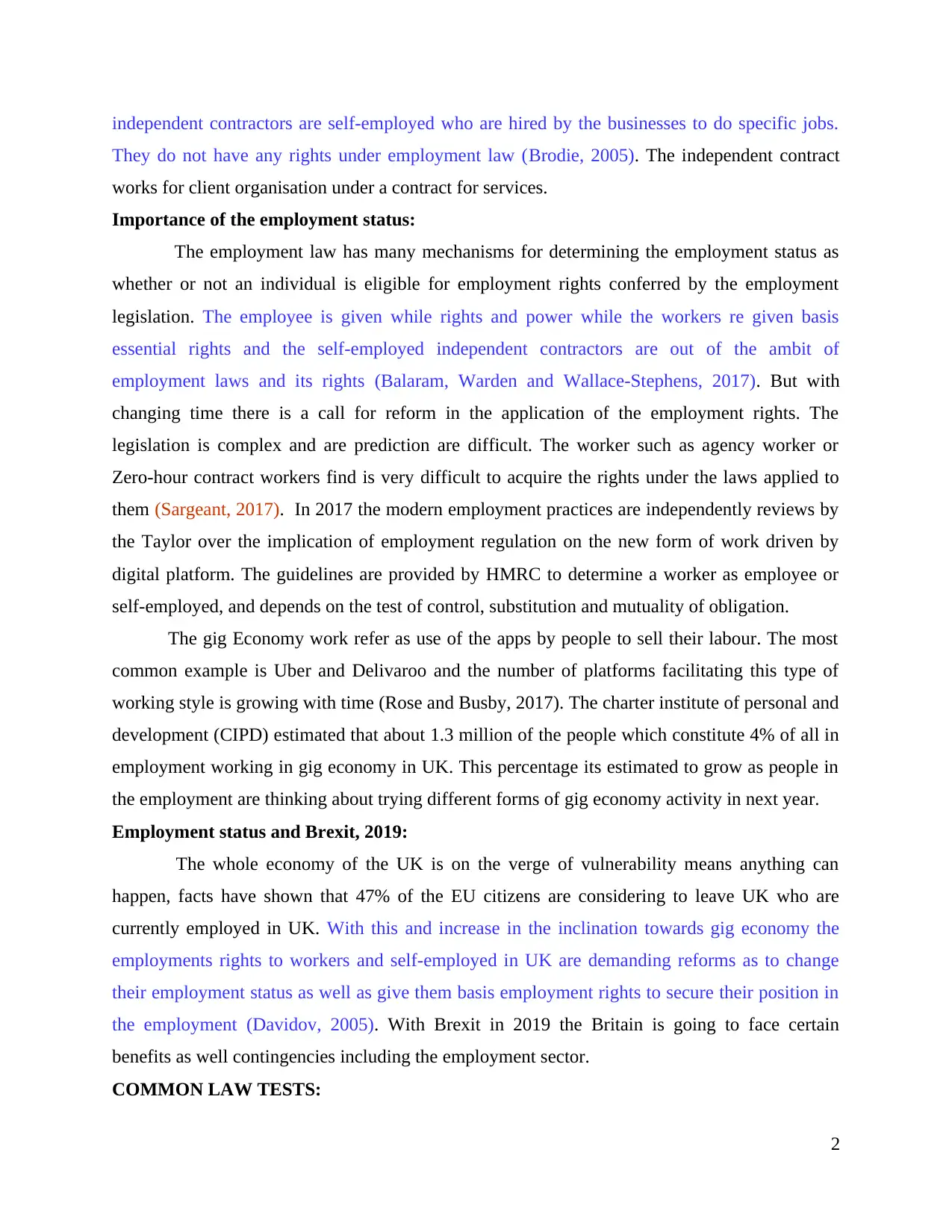
independent contractors are self-employed who are hired by the businesses to do specific jobs.
They do not have any rights under employment law (Brodie, 2005). The independent contract
works for client organisation under a contract for services.
Importance of the employment status:
The employment law has many mechanisms for determining the employment status as
whether or not an individual is eligible for employment rights conferred by the employment
legislation. The employee is given while rights and power while the workers re given basis
essential rights and the self-employed independent contractors are out of the ambit of
employment laws and its rights (Balaram, Warden and Wallace-Stephens, 2017). But with
changing time there is a call for reform in the application of the employment rights. The
legislation is complex and are prediction are difficult. The worker such as agency worker or
Zero-hour contract workers find is very difficult to acquire the rights under the laws applied to
them (Sargeant, 2017). In 2017 the modern employment practices are independently reviews by
the Taylor over the implication of employment regulation on the new form of work driven by
digital platform. The guidelines are provided by HMRC to determine a worker as employee or
self-employed, and depends on the test of control, substitution and mutuality of obligation.
The gig Economy work refer as use of the apps by people to sell their labour. The most
common example is Uber and Delivaroo and the number of platforms facilitating this type of
working style is growing with time (Rose and Busby, 2017). The charter institute of personal and
development (CIPD) estimated that about 1.3 million of the people which constitute 4% of all in
employment working in gig economy in UK. This percentage its estimated to grow as people in
the employment are thinking about trying different forms of gig economy activity in next year.
Employment status and Brexit, 2019:
The whole economy of the UK is on the verge of vulnerability means anything can
happen, facts have shown that 47% of the EU citizens are considering to leave UK who are
currently employed in UK. With this and increase in the inclination towards gig economy the
employments rights to workers and self-employed in UK are demanding reforms as to change
their employment status as well as give them basis employment rights to secure their position in
the employment (Davidov, 2005). With Brexit in 2019 the Britain is going to face certain
benefits as well contingencies including the employment sector.
COMMON LAW TESTS:
2
They do not have any rights under employment law (Brodie, 2005). The independent contract
works for client organisation under a contract for services.
Importance of the employment status:
The employment law has many mechanisms for determining the employment status as
whether or not an individual is eligible for employment rights conferred by the employment
legislation. The employee is given while rights and power while the workers re given basis
essential rights and the self-employed independent contractors are out of the ambit of
employment laws and its rights (Balaram, Warden and Wallace-Stephens, 2017). But with
changing time there is a call for reform in the application of the employment rights. The
legislation is complex and are prediction are difficult. The worker such as agency worker or
Zero-hour contract workers find is very difficult to acquire the rights under the laws applied to
them (Sargeant, 2017). In 2017 the modern employment practices are independently reviews by
the Taylor over the implication of employment regulation on the new form of work driven by
digital platform. The guidelines are provided by HMRC to determine a worker as employee or
self-employed, and depends on the test of control, substitution and mutuality of obligation.
The gig Economy work refer as use of the apps by people to sell their labour. The most
common example is Uber and Delivaroo and the number of platforms facilitating this type of
working style is growing with time (Rose and Busby, 2017). The charter institute of personal and
development (CIPD) estimated that about 1.3 million of the people which constitute 4% of all in
employment working in gig economy in UK. This percentage its estimated to grow as people in
the employment are thinking about trying different forms of gig economy activity in next year.
Employment status and Brexit, 2019:
The whole economy of the UK is on the verge of vulnerability means anything can
happen, facts have shown that 47% of the EU citizens are considering to leave UK who are
currently employed in UK. With this and increase in the inclination towards gig economy the
employments rights to workers and self-employed in UK are demanding reforms as to change
their employment status as well as give them basis employment rights to secure their position in
the employment (Davidov, 2005). With Brexit in 2019 the Britain is going to face certain
benefits as well contingencies including the employment sector.
COMMON LAW TESTS:
2
Paraphrase This Document
Need a fresh take? Get an instant paraphrase of this document with our AI Paraphraser
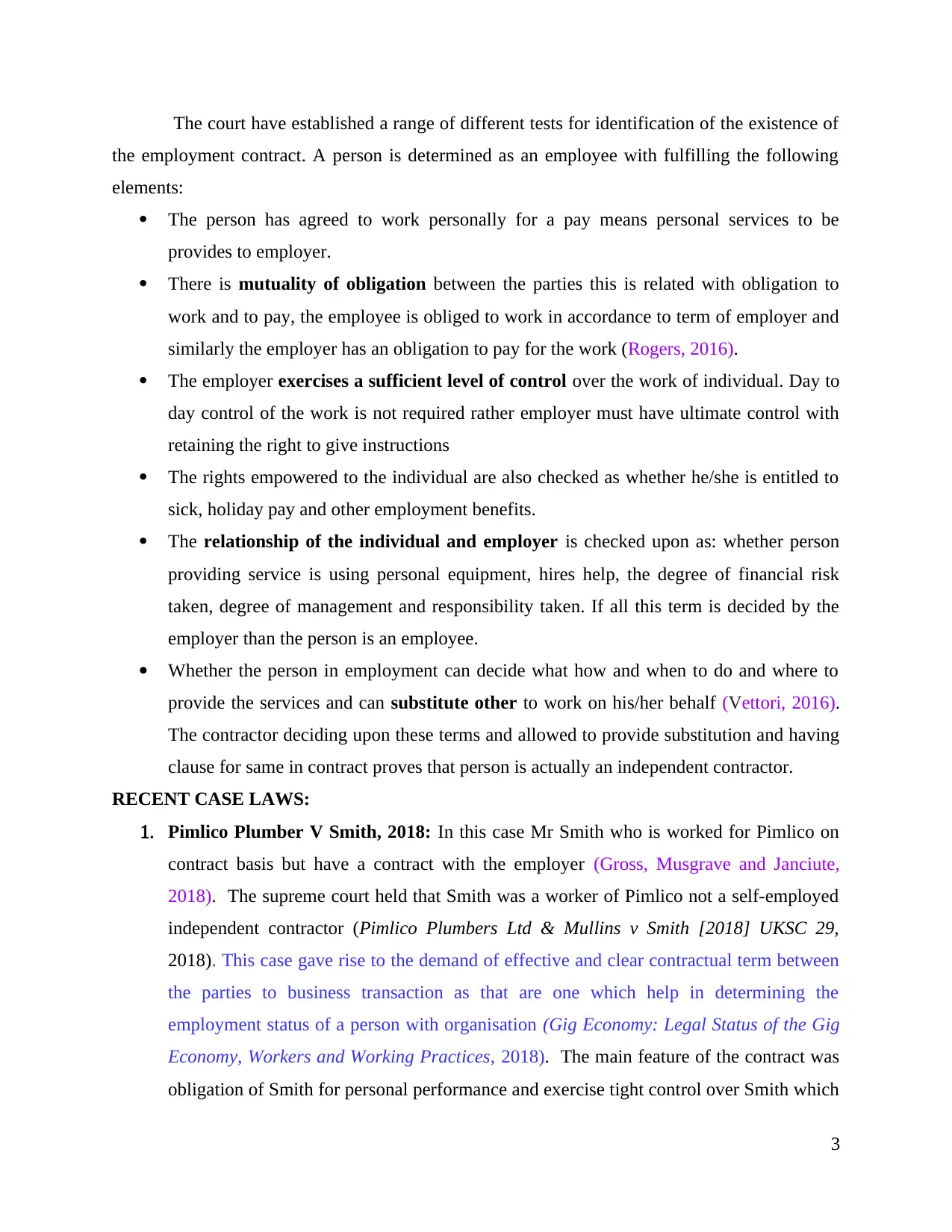
The court have established a range of different tests for identification of the existence of
the employment contract. A person is determined as an employee with fulfilling the following
elements:
The person has agreed to work personally for a pay means personal services to be
provides to employer.
There is mutuality of obligation between the parties this is related with obligation to
work and to pay, the employee is obliged to work in accordance to term of employer and
similarly the employer has an obligation to pay for the work (Rogers, 2016).
The employer exercises a sufficient level of control over the work of individual. Day to
day control of the work is not required rather employer must have ultimate control with
retaining the right to give instructions
The rights empowered to the individual are also checked as whether he/she is entitled to
sick, holiday pay and other employment benefits.
The relationship of the individual and employer is checked upon as: whether person
providing service is using personal equipment, hires help, the degree of financial risk
taken, degree of management and responsibility taken. If all this term is decided by the
employer than the person is an employee.
Whether the person in employment can decide what how and when to do and where to
provide the services and can substitute other to work on his/her behalf (Vettori, 2016).
The contractor deciding upon these terms and allowed to provide substitution and having
clause for same in contract proves that person is actually an independent contractor.
RECENT CASE LAWS:
1. Pimlico Plumber V Smith, 2018: In this case Mr Smith who is worked for Pimlico on
contract basis but have a contract with the employer (Gross, Musgrave and Janciute,
2018). The supreme court held that Smith was a worker of Pimlico not a self-employed
independent contractor (Pimlico Plumbers Ltd & Mullins v Smith [2018] UKSC 29,
2018). This case gave rise to the demand of effective and clear contractual term between
the parties to business transaction as that are one which help in determining the
employment status of a person with organisation (Gig Economy: Legal Status of the Gig
Economy, Workers and Working Practices, 2018). The main feature of the contract was
obligation of Smith for personal performance and exercise tight control over Smith which
3
the employment contract. A person is determined as an employee with fulfilling the following
elements:
The person has agreed to work personally for a pay means personal services to be
provides to employer.
There is mutuality of obligation between the parties this is related with obligation to
work and to pay, the employee is obliged to work in accordance to term of employer and
similarly the employer has an obligation to pay for the work (Rogers, 2016).
The employer exercises a sufficient level of control over the work of individual. Day to
day control of the work is not required rather employer must have ultimate control with
retaining the right to give instructions
The rights empowered to the individual are also checked as whether he/she is entitled to
sick, holiday pay and other employment benefits.
The relationship of the individual and employer is checked upon as: whether person
providing service is using personal equipment, hires help, the degree of financial risk
taken, degree of management and responsibility taken. If all this term is decided by the
employer than the person is an employee.
Whether the person in employment can decide what how and when to do and where to
provide the services and can substitute other to work on his/her behalf (Vettori, 2016).
The contractor deciding upon these terms and allowed to provide substitution and having
clause for same in contract proves that person is actually an independent contractor.
RECENT CASE LAWS:
1. Pimlico Plumber V Smith, 2018: In this case Mr Smith who is worked for Pimlico on
contract basis but have a contract with the employer (Gross, Musgrave and Janciute,
2018). The supreme court held that Smith was a worker of Pimlico not a self-employed
independent contractor (Pimlico Plumbers Ltd & Mullins v Smith [2018] UKSC 29,
2018). This case gave rise to the demand of effective and clear contractual term between
the parties to business transaction as that are one which help in determining the
employment status of a person with organisation (Gig Economy: Legal Status of the Gig
Economy, Workers and Working Practices, 2018). The main feature of the contract was
obligation of Smith for personal performance and exercise tight control over Smith which
3
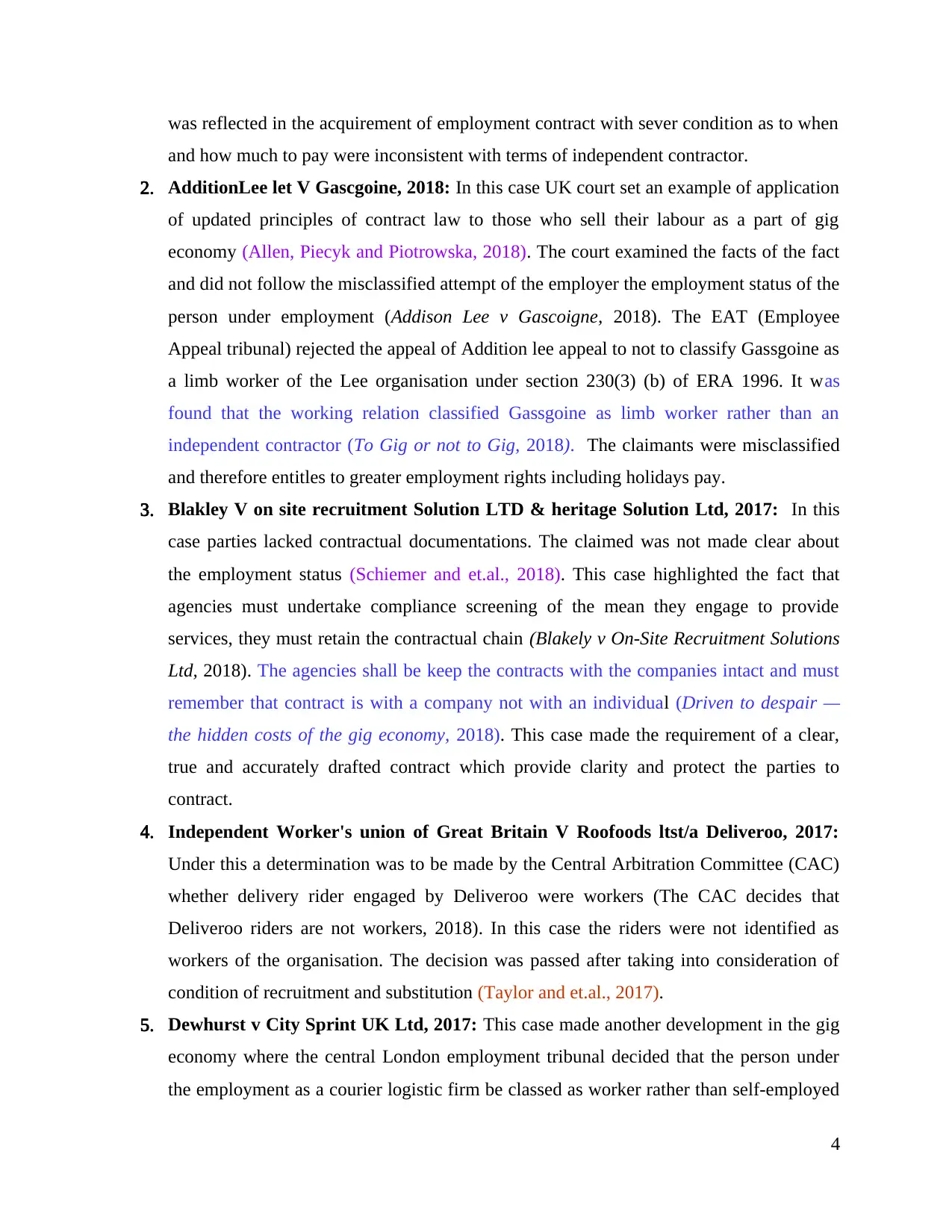
was reflected in the acquirement of employment contract with sever condition as to when
and how much to pay were inconsistent with terms of independent contractor.
2. AdditionLee let V Gascgoine, 2018: In this case UK court set an example of application
of updated principles of contract law to those who sell their labour as a part of gig
economy (Allen, Piecyk and Piotrowska, 2018). The court examined the facts of the fact
and did not follow the misclassified attempt of the employer the employment status of the
person under employment (Addison Lee v Gascoigne, 2018). The EAT (Employee
Appeal tribunal) rejected the appeal of Addition lee appeal to not to classify Gassgoine as
a limb worker of the Lee organisation under section 230(3) (b) of ERA 1996. It was
found that the working relation classified Gassgoine as limb worker rather than an
independent contractor (To Gig or not to Gig, 2018). The claimants were misclassified
and therefore entitles to greater employment rights including holidays pay.
3. Blakley V on site recruitment Solution LTD & heritage Solution Ltd, 2017: In this
case parties lacked contractual documentations. The claimed was not made clear about
the employment status (Schiemer and et.al., 2018). This case highlighted the fact that
agencies must undertake compliance screening of the mean they engage to provide
services, they must retain the contractual chain (Blakely v On-Site Recruitment Solutions
Ltd, 2018). The agencies shall be keep the contracts with the companies intact and must
remember that contract is with a company not with an individual (Driven to despair —
the hidden costs of the gig economy, 2018). This case made the requirement of a clear,
true and accurately drafted contract which provide clarity and protect the parties to
contract.
4. Independent Worker's union of Great Britain V Roofoods ltst/a Deliveroo, 2017:
Under this a determination was to be made by the Central Arbitration Committee (CAC)
whether delivery rider engaged by Deliveroo were workers (The CAC decides that
Deliveroo riders are not workers, 2018). In this case the riders were not identified as
workers of the organisation. The decision was passed after taking into consideration of
condition of recruitment and substitution (Taylor and et.al., 2017).
5. Dewhurst v City Sprint UK Ltd, 2017: This case made another development in the gig
economy where the central London employment tribunal decided that the person under
the employment as a courier logistic firm be classed as worker rather than self-employed
4
and how much to pay were inconsistent with terms of independent contractor.
2. AdditionLee let V Gascgoine, 2018: In this case UK court set an example of application
of updated principles of contract law to those who sell their labour as a part of gig
economy (Allen, Piecyk and Piotrowska, 2018). The court examined the facts of the fact
and did not follow the misclassified attempt of the employer the employment status of the
person under employment (Addison Lee v Gascoigne, 2018). The EAT (Employee
Appeal tribunal) rejected the appeal of Addition lee appeal to not to classify Gassgoine as
a limb worker of the Lee organisation under section 230(3) (b) of ERA 1996. It was
found that the working relation classified Gassgoine as limb worker rather than an
independent contractor (To Gig or not to Gig, 2018). The claimants were misclassified
and therefore entitles to greater employment rights including holidays pay.
3. Blakley V on site recruitment Solution LTD & heritage Solution Ltd, 2017: In this
case parties lacked contractual documentations. The claimed was not made clear about
the employment status (Schiemer and et.al., 2018). This case highlighted the fact that
agencies must undertake compliance screening of the mean they engage to provide
services, they must retain the contractual chain (Blakely v On-Site Recruitment Solutions
Ltd, 2018). The agencies shall be keep the contracts with the companies intact and must
remember that contract is with a company not with an individual (Driven to despair —
the hidden costs of the gig economy, 2018). This case made the requirement of a clear,
true and accurately drafted contract which provide clarity and protect the parties to
contract.
4. Independent Worker's union of Great Britain V Roofoods ltst/a Deliveroo, 2017:
Under this a determination was to be made by the Central Arbitration Committee (CAC)
whether delivery rider engaged by Deliveroo were workers (The CAC decides that
Deliveroo riders are not workers, 2018). In this case the riders were not identified as
workers of the organisation. The decision was passed after taking into consideration of
condition of recruitment and substitution (Taylor and et.al., 2017).
5. Dewhurst v City Sprint UK Ltd, 2017: This case made another development in the gig
economy where the central London employment tribunal decided that the person under
the employment as a courier logistic firm be classed as worker rather than self-employed
4
⊘ This is a preview!⊘
Do you want full access?
Subscribe today to unlock all pages.

Trusted by 1+ million students worldwide
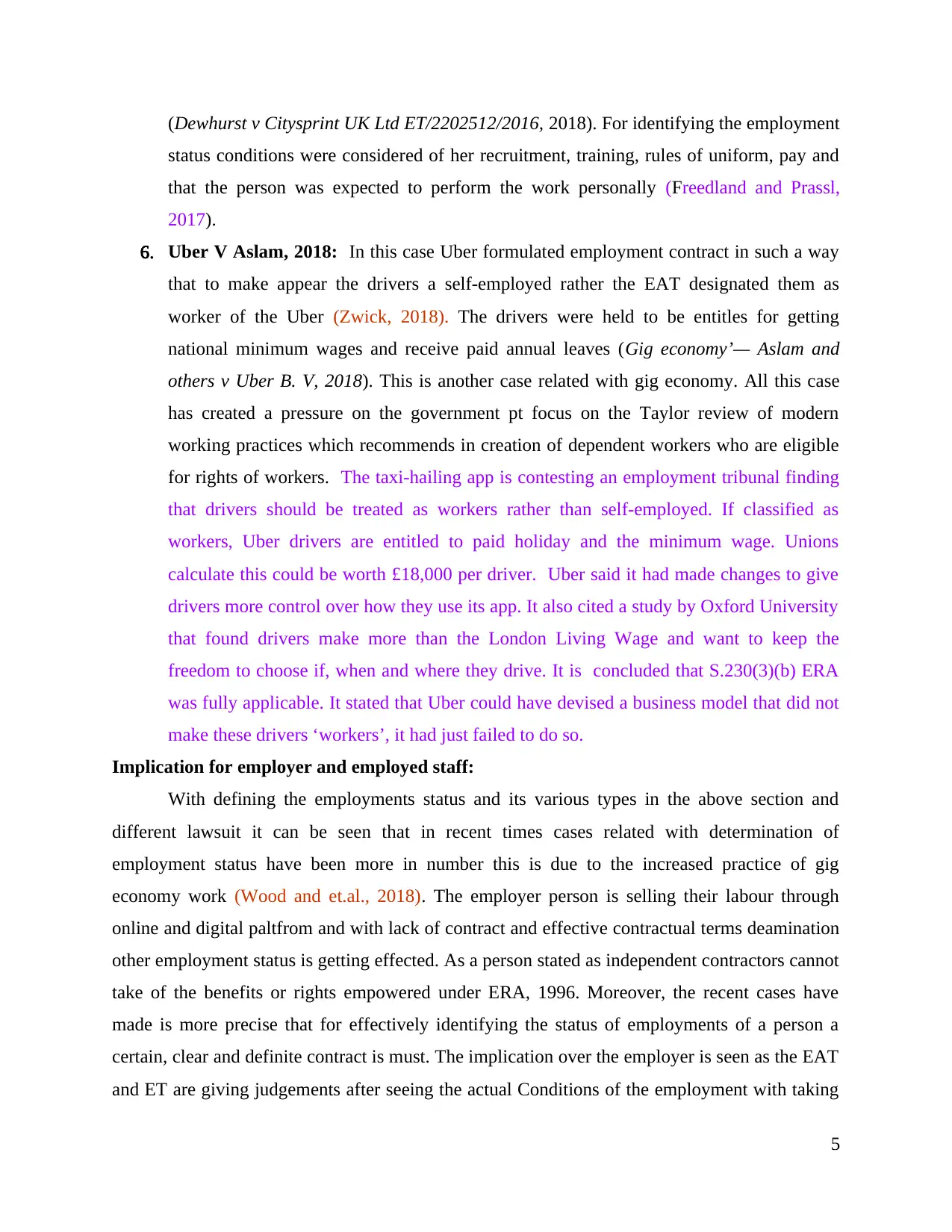
(Dewhurst v Citysprint UK Ltd ET/2202512/2016, 2018). For identifying the employment
status conditions were considered of her recruitment, training, rules of uniform, pay and
that the person was expected to perform the work personally (Freedland and Prassl,
2017).
6. Uber V Aslam, 2018: In this case Uber formulated employment contract in such a way
that to make appear the drivers a self-employed rather the EAT designated them as
worker of the Uber (Zwick, 2018). The drivers were held to be entitles for getting
national minimum wages and receive paid annual leaves (Gig economy’— Aslam and
others v Uber B. V, 2018). This is another case related with gig economy. All this case
has created a pressure on the government pt focus on the Taylor review of modern
working practices which recommends in creation of dependent workers who are eligible
for rights of workers. The taxi-hailing app is contesting an employment tribunal finding
that drivers should be treated as workers rather than self-employed. If classified as
workers, Uber drivers are entitled to paid holiday and the minimum wage. Unions
calculate this could be worth £18,000 per driver. Uber said it had made changes to give
drivers more control over how they use its app. It also cited a study by Oxford University
that found drivers make more than the London Living Wage and want to keep the
freedom to choose if, when and where they drive. It is concluded that S.230(3)(b) ERA
was fully applicable. It stated that Uber could have devised a business model that did not
make these drivers ‘workers’, it had just failed to do so.
Implication for employer and employed staff:
With defining the employments status and its various types in the above section and
different lawsuit it can be seen that in recent times cases related with determination of
employment status have been more in number this is due to the increased practice of gig
economy work (Wood and et.al., 2018). The employer person is selling their labour through
online and digital paltfrom and with lack of contract and effective contractual terms deamination
other employment status is getting effected. As a person stated as independent contractors cannot
take of the benefits or rights empowered under ERA, 1996. Moreover, the recent cases have
made is more precise that for effectively identifying the status of employments of a person a
certain, clear and definite contract is must. The implication over the employer is seen as the EAT
and ET are giving judgements after seeing the actual Conditions of the employment with taking
5
status conditions were considered of her recruitment, training, rules of uniform, pay and
that the person was expected to perform the work personally (Freedland and Prassl,
2017).
6. Uber V Aslam, 2018: In this case Uber formulated employment contract in such a way
that to make appear the drivers a self-employed rather the EAT designated them as
worker of the Uber (Zwick, 2018). The drivers were held to be entitles for getting
national minimum wages and receive paid annual leaves (Gig economy’— Aslam and
others v Uber B. V, 2018). This is another case related with gig economy. All this case
has created a pressure on the government pt focus on the Taylor review of modern
working practices which recommends in creation of dependent workers who are eligible
for rights of workers. The taxi-hailing app is contesting an employment tribunal finding
that drivers should be treated as workers rather than self-employed. If classified as
workers, Uber drivers are entitled to paid holiday and the minimum wage. Unions
calculate this could be worth £18,000 per driver. Uber said it had made changes to give
drivers more control over how they use its app. It also cited a study by Oxford University
that found drivers make more than the London Living Wage and want to keep the
freedom to choose if, when and where they drive. It is concluded that S.230(3)(b) ERA
was fully applicable. It stated that Uber could have devised a business model that did not
make these drivers ‘workers’, it had just failed to do so.
Implication for employer and employed staff:
With defining the employments status and its various types in the above section and
different lawsuit it can be seen that in recent times cases related with determination of
employment status have been more in number this is due to the increased practice of gig
economy work (Wood and et.al., 2018). The employer person is selling their labour through
online and digital paltfrom and with lack of contract and effective contractual terms deamination
other employment status is getting effected. As a person stated as independent contractors cannot
take of the benefits or rights empowered under ERA, 1996. Moreover, the recent cases have
made is more precise that for effectively identifying the status of employments of a person a
certain, clear and definite contract is must. The implication over the employer is seen as the EAT
and ET are giving judgements after seeing the actual Conditions of the employment with taking
5
Paraphrase This Document
Need a fresh take? Get an instant paraphrase of this document with our AI Paraphraser
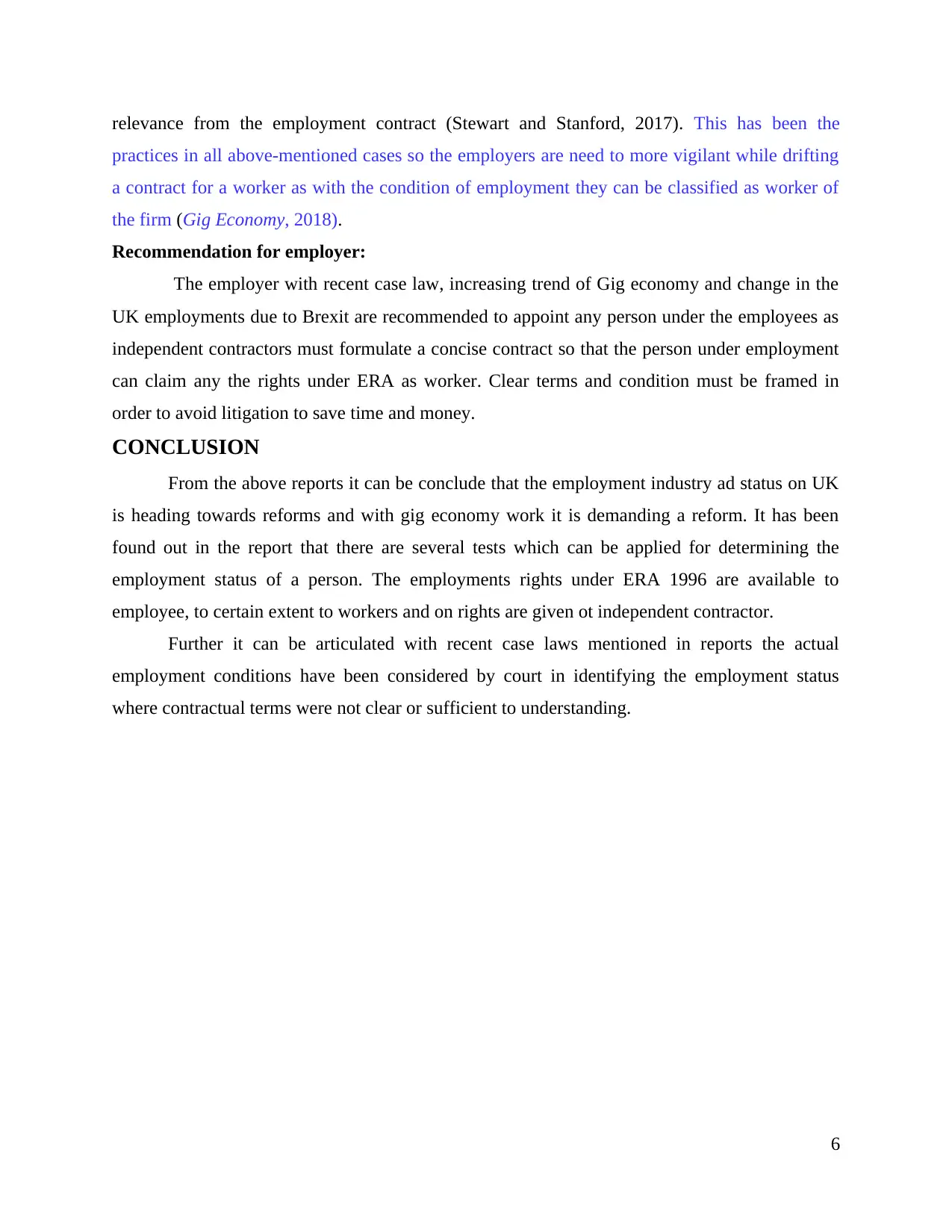
relevance from the employment contract (Stewart and Stanford, 2017). This has been the
practices in all above-mentioned cases so the employers are need to more vigilant while drifting
a contract for a worker as with the condition of employment they can be classified as worker of
the firm (Gig Economy, 2018).
Recommendation for employer:
The employer with recent case law, increasing trend of Gig economy and change in the
UK employments due to Brexit are recommended to appoint any person under the employees as
independent contractors must formulate a concise contract so that the person under employment
can claim any the rights under ERA as worker. Clear terms and condition must be framed in
order to avoid litigation to save time and money.
CONCLUSION
From the above reports it can be conclude that the employment industry ad status on UK
is heading towards reforms and with gig economy work it is demanding a reform. It has been
found out in the report that there are several tests which can be applied for determining the
employment status of a person. The employments rights under ERA 1996 are available to
employee, to certain extent to workers and on rights are given ot independent contractor.
Further it can be articulated with recent case laws mentioned in reports the actual
employment conditions have been considered by court in identifying the employment status
where contractual terms were not clear or sufficient to understanding.
6
practices in all above-mentioned cases so the employers are need to more vigilant while drifting
a contract for a worker as with the condition of employment they can be classified as worker of
the firm (Gig Economy, 2018).
Recommendation for employer:
The employer with recent case law, increasing trend of Gig economy and change in the
UK employments due to Brexit are recommended to appoint any person under the employees as
independent contractors must formulate a concise contract so that the person under employment
can claim any the rights under ERA as worker. Clear terms and condition must be framed in
order to avoid litigation to save time and money.
CONCLUSION
From the above reports it can be conclude that the employment industry ad status on UK
is heading towards reforms and with gig economy work it is demanding a reform. It has been
found out in the report that there are several tests which can be applied for determining the
employment status of a person. The employments rights under ERA 1996 are available to
employee, to certain extent to workers and on rights are given ot independent contractor.
Further it can be articulated with recent case laws mentioned in reports the actual
employment conditions have been considered by court in identifying the employment status
where contractual terms were not clear or sufficient to understanding.
6
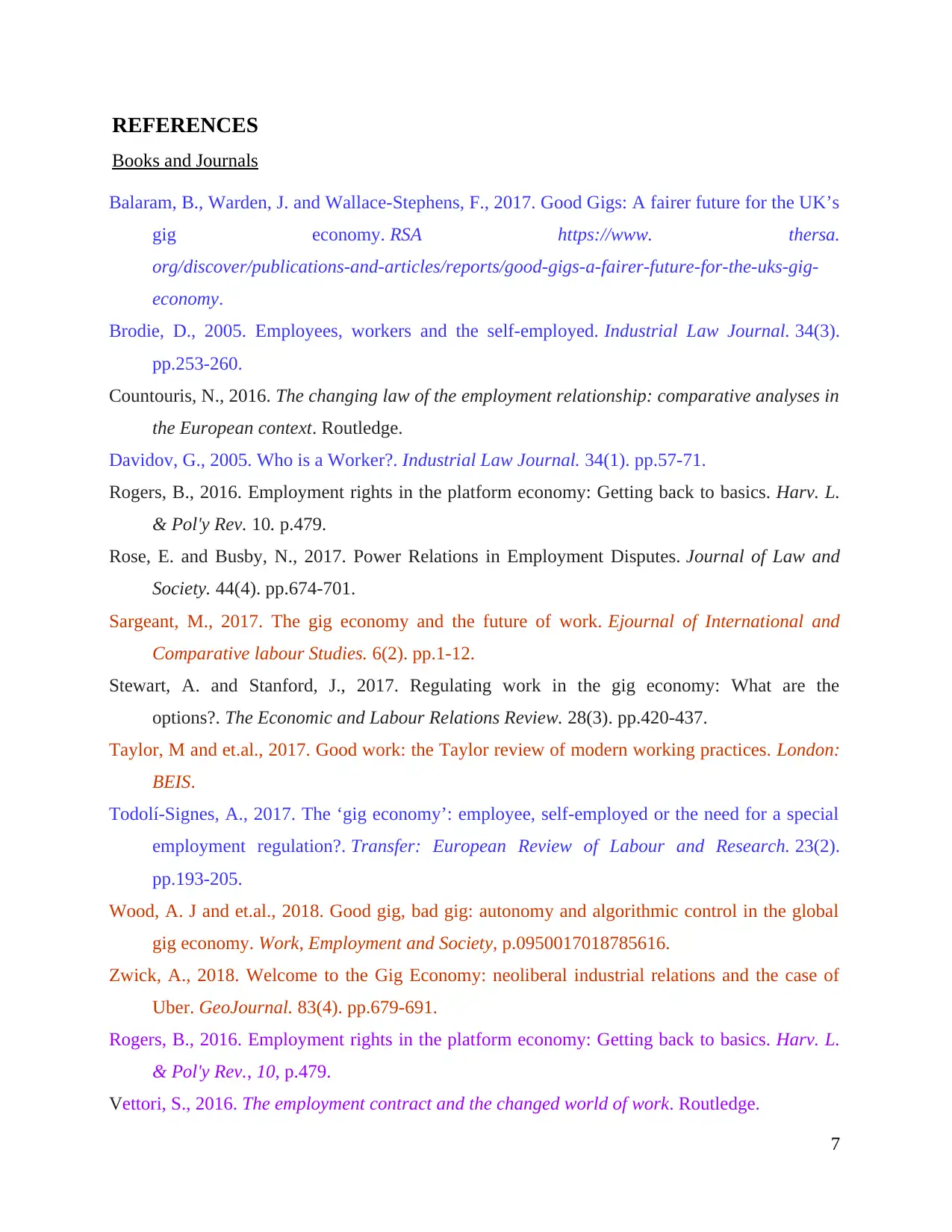
REFERENCES
Books and Journals
Balaram, B., Warden, J. and Wallace-Stephens, F., 2017. Good Gigs: A fairer future for the UK’s
gig economy. RSA https://www. thersa.
org/discover/publications-and-articles/reports/good-gigs-a-fairer-future-for-the-uks-gig-
economy.
Brodie, D., 2005. Employees, workers and the self-employed. Industrial Law Journal. 34(3).
pp.253-260.
Countouris, N., 2016. The changing law of the employment relationship: comparative analyses in
the European context. Routledge.
Davidov, G., 2005. Who is a Worker?. Industrial Law Journal. 34(1). pp.57-71.
Rogers, B., 2016. Employment rights in the platform economy: Getting back to basics. Harv. L.
& Pol'y Rev. 10. p.479.
Rose, E. and Busby, N., 2017. Power Relations in Employment Disputes. Journal of Law and
Society. 44(4). pp.674-701.
Sargeant, M., 2017. The gig economy and the future of work. Ejournal of International and
Comparative labour Studies. 6(2). pp.1-12.
Stewart, A. and Stanford, J., 2017. Regulating work in the gig economy: What are the
options?. The Economic and Labour Relations Review. 28(3). pp.420-437.
Taylor, M and et.al., 2017. Good work: the Taylor review of modern working practices. London:
BEIS.
Todolí-Signes, A., 2017. The ‘gig economy’: employee, self-employed or the need for a special
employment regulation?. Transfer: European Review of Labour and Research. 23(2).
pp.193-205.
Wood, A. J and et.al., 2018. Good gig, bad gig: autonomy and algorithmic control in the global
gig economy. Work, Employment and Society, p.0950017018785616.
Zwick, A., 2018. Welcome to the Gig Economy: neoliberal industrial relations and the case of
Uber. GeoJournal. 83(4). pp.679-691.
Rogers, B., 2016. Employment rights in the platform economy: Getting back to basics. Harv. L.
& Pol'y Rev., 10, p.479.
Vettori, S., 2016. The employment contract and the changed world of work. Routledge.
7
Books and Journals
Balaram, B., Warden, J. and Wallace-Stephens, F., 2017. Good Gigs: A fairer future for the UK’s
gig economy. RSA https://www. thersa.
org/discover/publications-and-articles/reports/good-gigs-a-fairer-future-for-the-uks-gig-
economy.
Brodie, D., 2005. Employees, workers and the self-employed. Industrial Law Journal. 34(3).
pp.253-260.
Countouris, N., 2016. The changing law of the employment relationship: comparative analyses in
the European context. Routledge.
Davidov, G., 2005. Who is a Worker?. Industrial Law Journal. 34(1). pp.57-71.
Rogers, B., 2016. Employment rights in the platform economy: Getting back to basics. Harv. L.
& Pol'y Rev. 10. p.479.
Rose, E. and Busby, N., 2017. Power Relations in Employment Disputes. Journal of Law and
Society. 44(4). pp.674-701.
Sargeant, M., 2017. The gig economy and the future of work. Ejournal of International and
Comparative labour Studies. 6(2). pp.1-12.
Stewart, A. and Stanford, J., 2017. Regulating work in the gig economy: What are the
options?. The Economic and Labour Relations Review. 28(3). pp.420-437.
Taylor, M and et.al., 2017. Good work: the Taylor review of modern working practices. London:
BEIS.
Todolí-Signes, A., 2017. The ‘gig economy’: employee, self-employed or the need for a special
employment regulation?. Transfer: European Review of Labour and Research. 23(2).
pp.193-205.
Wood, A. J and et.al., 2018. Good gig, bad gig: autonomy and algorithmic control in the global
gig economy. Work, Employment and Society, p.0950017018785616.
Zwick, A., 2018. Welcome to the Gig Economy: neoliberal industrial relations and the case of
Uber. GeoJournal. 83(4). pp.679-691.
Rogers, B., 2016. Employment rights in the platform economy: Getting back to basics. Harv. L.
& Pol'y Rev., 10, p.479.
Vettori, S., 2016. The employment contract and the changed world of work. Routledge.
7
⊘ This is a preview!⊘
Do you want full access?
Subscribe today to unlock all pages.

Trusted by 1+ million students worldwide
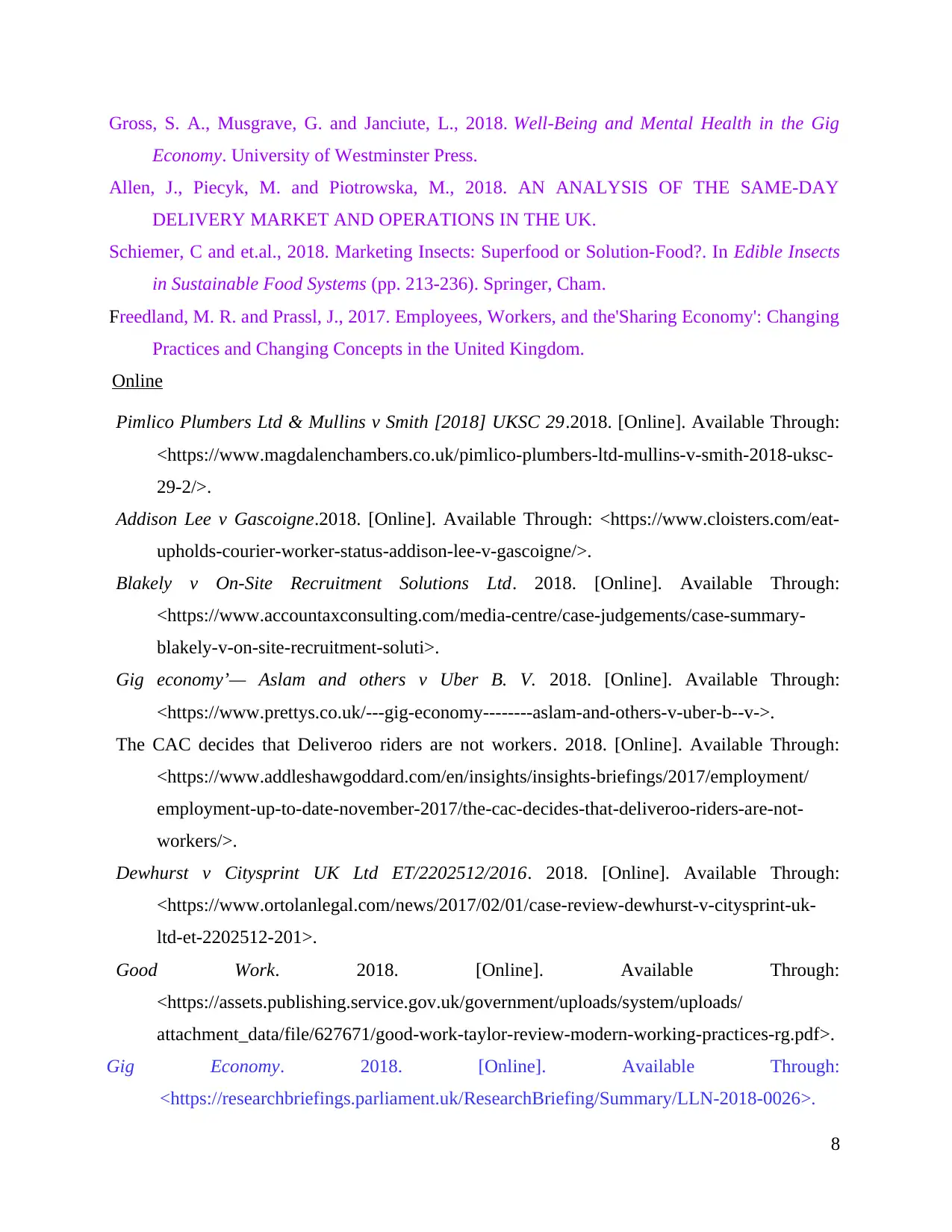
Gross, S. A., Musgrave, G. and Janciute, L., 2018. Well-Being and Mental Health in the Gig
Economy. University of Westminster Press.
Allen, J., Piecyk, M. and Piotrowska, M., 2018. AN ANALYSIS OF THE SAME-DAY
DELIVERY MARKET AND OPERATIONS IN THE UK.
Schiemer, C and et.al., 2018. Marketing Insects: Superfood or Solution-Food?. In Edible Insects
in Sustainable Food Systems (pp. 213-236). Springer, Cham.
Freedland, M. R. and Prassl, J., 2017. Employees, Workers, and the'Sharing Economy': Changing
Practices and Changing Concepts in the United Kingdom.
Online
Pimlico Plumbers Ltd & Mullins v Smith [2018] UKSC 29.2018. [Online]. Available Through:
<https://www.magdalenchambers.co.uk/pimlico-plumbers-ltd-mullins-v-smith-2018-uksc-
29-2/>.
Addison Lee v Gascoigne.2018. [Online]. Available Through: <https://www.cloisters.com/eat-
upholds-courier-worker-status-addison-lee-v-gascoigne/>.
Blakely v On-Site Recruitment Solutions Ltd. 2018. [Online]. Available Through:
<https://www.accountaxconsulting.com/media-centre/case-judgements/case-summary-
blakely-v-on-site-recruitment-soluti>.
Gig economy’— Aslam and others v Uber B. V. 2018. [Online]. Available Through:
<https://www.prettys.co.uk/---gig-economy--------aslam-and-others-v-uber-b--v->.
The CAC decides that Deliveroo riders are not workers. 2018. [Online]. Available Through:
<https://www.addleshawgoddard.com/en/insights/insights-briefings/2017/employment/
employment-up-to-date-november-2017/the-cac-decides-that-deliveroo-riders-are-not-
workers/>.
Dewhurst v Citysprint UK Ltd ET/2202512/2016. 2018. [Online]. Available Through:
<https://www.ortolanlegal.com/news/2017/02/01/case-review-dewhurst-v-citysprint-uk-
ltd-et-2202512-201>.
Good Work. 2018. [Online]. Available Through:
<https://assets.publishing.service.gov.uk/government/uploads/system/uploads/
attachment_data/file/627671/good-work-taylor-review-modern-working-practices-rg.pdf>.
Gig Economy. 2018. [Online]. Available Through:
<https://researchbriefings.parliament.uk/ResearchBriefing/Summary/LLN-2018-0026>.
8
Economy. University of Westminster Press.
Allen, J., Piecyk, M. and Piotrowska, M., 2018. AN ANALYSIS OF THE SAME-DAY
DELIVERY MARKET AND OPERATIONS IN THE UK.
Schiemer, C and et.al., 2018. Marketing Insects: Superfood or Solution-Food?. In Edible Insects
in Sustainable Food Systems (pp. 213-236). Springer, Cham.
Freedland, M. R. and Prassl, J., 2017. Employees, Workers, and the'Sharing Economy': Changing
Practices and Changing Concepts in the United Kingdom.
Online
Pimlico Plumbers Ltd & Mullins v Smith [2018] UKSC 29.2018. [Online]. Available Through:
<https://www.magdalenchambers.co.uk/pimlico-plumbers-ltd-mullins-v-smith-2018-uksc-
29-2/>.
Addison Lee v Gascoigne.2018. [Online]. Available Through: <https://www.cloisters.com/eat-
upholds-courier-worker-status-addison-lee-v-gascoigne/>.
Blakely v On-Site Recruitment Solutions Ltd. 2018. [Online]. Available Through:
<https://www.accountaxconsulting.com/media-centre/case-judgements/case-summary-
blakely-v-on-site-recruitment-soluti>.
Gig economy’— Aslam and others v Uber B. V. 2018. [Online]. Available Through:
<https://www.prettys.co.uk/---gig-economy--------aslam-and-others-v-uber-b--v->.
The CAC decides that Deliveroo riders are not workers. 2018. [Online]. Available Through:
<https://www.addleshawgoddard.com/en/insights/insights-briefings/2017/employment/
employment-up-to-date-november-2017/the-cac-decides-that-deliveroo-riders-are-not-
workers/>.
Dewhurst v Citysprint UK Ltd ET/2202512/2016. 2018. [Online]. Available Through:
<https://www.ortolanlegal.com/news/2017/02/01/case-review-dewhurst-v-citysprint-uk-
ltd-et-2202512-201>.
Good Work. 2018. [Online]. Available Through:
<https://assets.publishing.service.gov.uk/government/uploads/system/uploads/
attachment_data/file/627671/good-work-taylor-review-modern-working-practices-rg.pdf>.
Gig Economy. 2018. [Online]. Available Through:
<https://researchbriefings.parliament.uk/ResearchBriefing/Summary/LLN-2018-0026>.
8
Paraphrase This Document
Need a fresh take? Get an instant paraphrase of this document with our AI Paraphraser

Driven to despair — the hidden costs of the gig economy. 2018. [Online]. Available Through:
<https://www.ft.com/content/749cb87e-6ca8-11e7-b9c7-15af748b60d0>.
To Gig or not to Gig. 2018. [PDF]. Available Through: <https://www.cipd.co.uk/Images/to-gig-
or-not-to-gig_2017-stories-from-the-modern-economy_tcm18-18955.pdf>.
Gig Economy: Legal Status of the Gig Economy, Workers and Working Practices. 2018. [Online].
Available Through:
<https://researchbriefings.parliament.uk/ResearchBriefing/Summary/LLN-2017-0086>.
9
<https://www.ft.com/content/749cb87e-6ca8-11e7-b9c7-15af748b60d0>.
To Gig or not to Gig. 2018. [PDF]. Available Through: <https://www.cipd.co.uk/Images/to-gig-
or-not-to-gig_2017-stories-from-the-modern-economy_tcm18-18955.pdf>.
Gig Economy: Legal Status of the Gig Economy, Workers and Working Practices. 2018. [Online].
Available Through:
<https://researchbriefings.parliament.uk/ResearchBriefing/Summary/LLN-2017-0086>.
9
1 out of 11
Related Documents
Your All-in-One AI-Powered Toolkit for Academic Success.
+13062052269
info@desklib.com
Available 24*7 on WhatsApp / Email
![[object Object]](/_next/static/media/star-bottom.7253800d.svg)
Unlock your academic potential
Copyright © 2020–2025 A2Z Services. All Rights Reserved. Developed and managed by ZUCOL.





